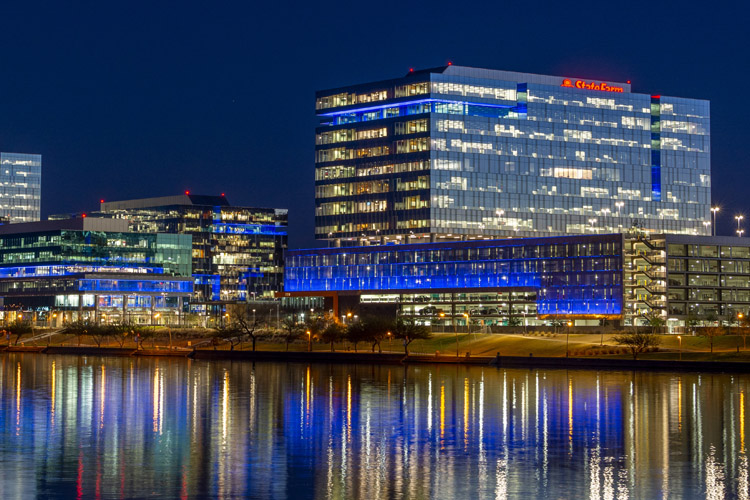As more and more companies continue to expand their operations in Tempe – such as State Farm, which recently announced its intention to hire an additional 1,100 employees at its offices near Tempe Town Lake – City of Tempe officials have reason to believe that Tempe’s growth spurt isn’t about to end anytime soon.
According to Ambika Adhikari, a Principal Planner at the City of Tempe’s Community Development Department, the city’s annual population growth averages between 1.5 and 2 percent, or roughly 3,000 new residents per year. If that trend continues, with a compounded growth, Adhikari says the city could have over 70,000 new residents by 2040.
Those projections also predict half of those new residents will be in Tempe’s Urban Core, which is the approximately 6 square mile area that encompasses downtown Tempe, Tempe Town Lake, Arizona State University and more. That sort of growth could lead to some 14,000 new dwelling units, millions of square feet of new office and retail development, and an estimated 16,000 new jobs.
“We have a lot of jobs that are coming here in Tempe,” said Anne Gill, President and CEO of the Tempe Chamber of Commerce. “In our urban core, planning for the future is vital to its success.”
To help prepare for the anticipated growth, Adhikari says it’s important that the city finds a way to balance the priorities and interests of its business and residential communities. That’s a key focus of what Tempe calls its Urban Core Master Plan – a collection of new policies and guidelines being designed to help the city guide balanced, sustainable growth and protect the character of existing neighborhoods and historic areas.
“When you plan for this kind of area, you’ve got to think of what kind of heights and densities are required in order to accommodate that kind of growth in a more reasonable manner,” Adhikari said. “The Urban Core Master Plan tries to accommodate that kind of prediction.”
Tempe’s Urban Core Master Plan consists of three separate but connected components – the Urban Core Master Plan itself, an Updated Transportation Overlay District (TOD) and an Affordable Housing Strategy. Tempe’s City Council directed staff to begin preparing the plans in late 2017.
The first component — the Urban Core Master Plan itself — if adopted, will set forth locations and design guidelines for developers building in Tempe via a policy-level document. Examples of potential policies and guidelines include recommendations for ideal building heights and designs, the ideal width of new sidewalks, the appropriate shading along city streetscapes, and other factors to help ensure walkability and sustainability
The Urban Core Master Plan – which is over 100 pages long in its current draft form – could also help guide land developers to where they should propose constructing new buildings of varying heights and densities, Adhikari said. For example, the guidelines might steer developers away from constructing high-rise properties in established neighborhoods of single-family homes.
Adhikari said the city has held numerous public meetings with residents, businesses and local organizations to try and understand their priorities and create balanced guidelines. And, while the Urban Core Master Plan isn’t a regulatory document and won’t affect existing zoning, Adhikari says he thinks the plan will be a useful document for everyone with a stake in Tempe’s growth,
“Really this is about, here’s our shared vision of the future,” Adhikari said.
The second major component of the Urban Core Master Plan is an updated and expanded Transportation Overlay District (TOD). The goal of the TOD is to establish development standards and guidelines for properties located within close proximity to transit stops and corridors, with the aim of encouraging “appropriate land development and redevelopment that is consistent with and complementary to the community’s focused investment in transit, bicycle and pedestrian infrastructure,” according to the city‘s website.
Because Tempe is currently in the process of constructing a new streetcar line – which is mostly funded by federal grants, Adhikari said – Tempe is required to update the TOD to incorporate Tempe’s upcoming streetcar route and stop areas. The new TOD, which is now being called the Urban Code District, will only change the zoning when the property owner opts into the new district.
“The city’s not going and changing anybody’s zones or anybody’s right to property,” he said. “These are all basically planning efforts to envision what will be good for the city in the future.”
The third component of the Urban Core Master Plan is Tempe’s new Affordable Housing Strategy, which was adopted by Tempe City Council on July 31. The goal of the Affordable Housing Strategy, Adhikari said, was to create a “policy-level document identifying and recommending certain plans of action to improve the availability of affordable housing in Tempe.”
“There are always issues related to affordability, because any time a new development comes in, some people worry that it might displace the residents who have been there for a long time,” Adhikari said. “So, when we did the Affordable Housing Strategy, we collected a lot of public input.”
The Affordable Housing Strategy includes recommendations designed to help the city and developers do things like maintain the affordability of existing units and create an Affordable Housing Trust Fund. And while Adhikari said Tempe can’t legally require developers to build affordable housing, the city does plan on offering incentives such as development bonuses to encourage them to do so.
While the Urban Core Master Plan and the Urban Code District are still in the works, Adhikari said staff has been receiving good feedback from residents and the business community on the plan’s various components
“By-and-large, the business community seems to be pretty happy with the direction that we’re going,” he said. “It just identifies locations to accommodate the future growth in a much more well-planned manner so that it is good for everyone.”
This story was originally published at Chamber Business News.




